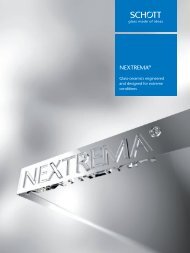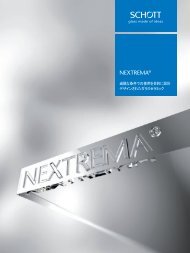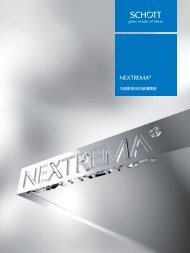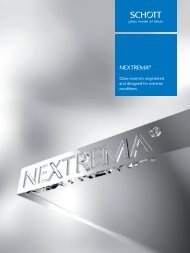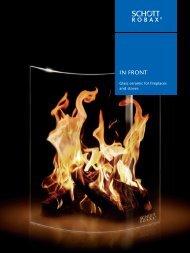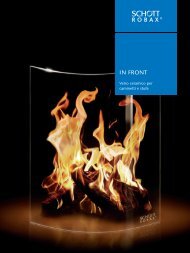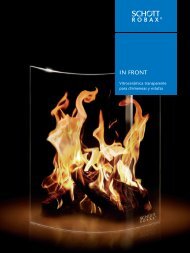SCHOTT Technical Glasses
Apart from its application in optics, glass as a technical material has exerted a formative influence on the development of important technological fields such as chemistry, pharmaceutics, automotive, optics, optoelectronics and information technology. SCHOTT Technical Glasses offers pertinent information in concise form. It contains general information for the determination and evaluation of important glass properties and also informs about specific chemical and physical characteristics and possible applications of the commercial technical glasses produced by SCHOTT. With this brochure, we hope to assist scientists, engineers, and designers in making the appropriate choice and make optimum use of SCHOTT products.
Apart from its application in optics, glass as a technical material has exerted a formative influence on the development of important technological fields such as chemistry, pharmaceutics, automotive, optics, optoelectronics and information technology. SCHOTT Technical Glasses offers pertinent information in concise form. It contains general information for the determination and evaluation of important glass properties and also informs about specific chemical and physical characteristics and possible applications of the commercial technical glasses produced by SCHOTT. With this brochure, we hope to assist scientists, engineers, and designers in making the appropriate choice and make optimum use of SCHOTT products.
You also want an ePaper? Increase the reach of your titles
YUMPU automatically turns print PDFs into web optimized ePapers that Google loves.
17<br />
a superimposed tensile stress keeps the surface under total<br />
compressive load. Thus, surface condition, loading rate, and<br />
loading time do not influence the strength.<br />
3.3 Elasticity<br />
The ideal brittleness of glasses and glass-ceramics is matched<br />
by an equally ideal elastic behavior up to the breaking point.<br />
The elastic moduli for most technical glasses is within the<br />
range of 50 – 90 GPa. The mean value of 70 GPa is about<br />
equal to Young’s modulus of aluminum. Poisson’s ratio of<br />
most glasses is in the range 0.21 to 0.25 and is lower than<br />
for metals or plastics.<br />
3.4 Coefficient of linear thermal expansion<br />
perature (section A), the curve shows a distinct bend and<br />
then gradually increases up to the beginning of the experimentally<br />
detectable plastic behavior (section B = quasi-linear<br />
region). A distinct bend in the extension curve characterizes<br />
the transition from the predominantly elastic to the more<br />
visco elastic behavior of the glass (section C = transformation<br />
range). As a result of increasing structural mobility, the<br />
temperature dependencies of almost all glass properties<br />
are distinctly changed. This transformation range is characterized<br />
by the transformation temperature T g according to<br />
ISO 7884-8. Figure 13 shows the linear thermal expansion<br />
curves of five glasses; 8330 and 4210 roughly define the normal<br />
range of technical glasses, with expansion coefficients<br />
α (20 °C; 300 °C) = 3.3 – 12 x 10 –6 /K. The linear thermal expansion<br />
is an essential variable for the sealability of glasses with<br />
other materials and for thermally induced stress formation,<br />
and is therefore of prime importance for glass applications.<br />
3<br />
With few exceptions, the length and the volume of glasses<br />
increase with increasing temperature (positive coefficient).<br />
The typical curve begins with a zero gradient at absolute<br />
zero (Figure 12) and increases slowly. At about room temσ<br />
D<br />
in MPa ––><br />
100<br />
80<br />
60<br />
40<br />
20<br />
Lifetime:<br />
10 2 s (1.7 min)<br />
10 5 s (1.2 days)<br />
10 8 s (3.17 years)<br />
10 11 s (3170 years)<br />
0<br />
0 20 40 60 80 100 120 140<br />
σ E<br />
in MPa ––><br />
3<br />
nominal strength<br />
values for<br />
99<br />
normal<br />
glass 95<br />
constructions<br />
80<br />
chem.-<br />
techn.<br />
largescale<br />
units<br />
5<br />
7<br />
60<br />
50<br />
40<br />
20<br />
10<br />
6<br />
4<br />
2<br />
1<br />
F in % ––><br />
10<br />
20<br />
S = 10000 1000 100 10 mm 2<br />
30<br />
50<br />
70<br />
100<br />
200 300<br />
σ E in MPa ––><br />
Fig. 9. Time-related strength σ D (strength under constant loading)<br />
compared to experimental strength σ˙ E at 10 MPa/s stress increase with<br />
lifetime t L , in normally humid atmosphere (soda-lime glass).<br />
Fig. 10. Failure probability F for differently sized stressed areas S;<br />
all samples abraded with 600 mesh grit, stress rate σ˙ = 10 MPa/s






